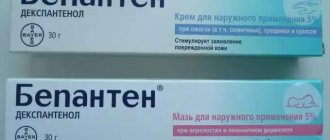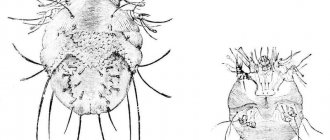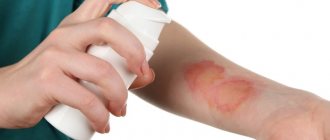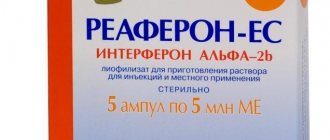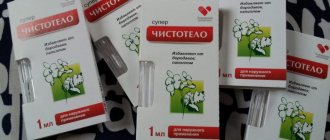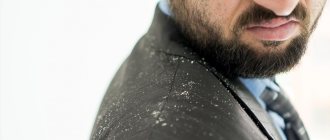Compound
| Solution for external use | 1 g |
| active substances: | |
| betamethasone dipropionate | 0.64 mg (0.064%) |
| (corresponds to 0.5 mg betamethasone) | |
| salicylic acid | 20 mg (2%) |
| excipients: disodium edetate - 0.3 mg; hypromellose 4000 cP - 5 mg; sodium hydroxide - 5 mg; isopropanol - 392 mg; water - 577.06 mg |
| Solution for external use in a bottle with a spray nozzle (spray) | 1 g |
| active substances: | |
| betamethasone dipropionate | 0.64 mg |
| (corresponds to 0.5 mg betamethasone) | |
| salicylic acid | 20 mg |
| excipients: disodium edetate - 0.3 mg; hypromellose 4000 cP - 5 mg; sodium hydroxide - 5 mg; isopropanol - 392 mg; water - 577.06 mg |
Pharmacodynamics
Belosalik®lotion has anti-inflammatory, antipruritic, anti-edematous, antiallergic, antiproliferative, immunosuppressive, keratolytic, antimicrobial and antifungal effects.
Betamethasone dipropionate is a synthetic corticosteroid that has anti-inflammatory, antiallergic, antipruritic and vasoconstrictor effects. When applied to the surface of the skin, it constricts blood vessels, relieves itching, reduces the release of inflammatory mediators (from eosinophils and mast cells), IL-1 and -2, interferon gamma (from lymphocytes and macrophages), inhibits the activity of hyaluronidase and reduces the permeability of the vascular wall. Interacts with specific receptors in the cytoplasm of the cell, stimulates the synthesis of mRNA, inducing the formation of proteins, incl. lipocortin, mediating cellular effects. Lipocortin inhibits phospholipase A2, blocks the release of arachidonic acid and the biosynthesis of endoperoxides, PGs, and leukotrienes (which contribute to the development of inflammation, allergies and other pathological processes).
Salicylic acid, due to its keratolytic action, cleanses affected areas of scales, promotes the penetration of betamethasone into the skin, maintains the acidic environment of the skin, preventing the development of bacterial and fungal infections.
Use during pregnancy and breastfeeding
Local use of the drug Belosalik® lotion in pregnant women is permitted in cases where the expected benefit to the mother outweighs the risk to the fetus. In such cases, the use of the medicine should be short-term and limited to small areas of the skin.
During breastfeeding, the use of the drug Belosalik® lotion is possible according to strict indications, however, the drug should not be applied to the skin of the mammary gland before feeding.
Analogues of the drug Belosalik
According to the instructions for the ointment and lotion, these drugs can be used for children aged 6 months and older. However, it is recommended that the use of the drug in such patients be shorter, since children have an increased likelihood of systemic absorption of the active components. Do not use ointment or lotion under bandages or under diapers.
During pregnancy, the solution for external use and/or Belosalik ointment can be used only in cases where the expected benefit for the woman outweighs the potential risk to the fetus. Treatment should be short-term, and when applying the drug to the skin, it should be limited to small areas.
During lactation, the use of Belosalik is possible only under strict indications. The drug should not be applied immediately before feeding to the skin in the mammary glands.
Analogues are determined by structure:
- Rederm;
- Betaderm A;
- Betasal;
- Akriderm SK;
- Belosalik lotion;
- Diprosalik;
- Betnovate S.
Drugs for the treatment of psoriasis include analogues:
- Celeston;
- Heptavit;
- Decortin;
- Ibusan;
- Essentiale forte N;
- Imunofan;
- Synoderm;
- Elokom;
- Phosphogliv forte;
- Ultralan;
- Kenacort;
- We see;
- Methotrexate;
- Essliver forte;
- Pyrogenal;
- Akriderm;
- Afloderm;
- Skin cap;
- Lycopid;
- Lokoid;
- Glutoxim;
- Loma Psoriasis;
- Polcortolon;
- Radevit;
- Beloderm;
- Diprosalik;
- Eslidin;
- Apulein;
- Celestoderm B;
- Laticort;
- Psoriatic;
- Belogent;
- Oxoralen;
- Perfect;
- Diprospan;
- Triacort;
- Betaderm;
- Hydrocortisone;
- Prednisolone;
- Pyridoxine;
- Flucourt;
- Kenalog;
- Lorinden;
- Eikonol;
- Azathioprine;
- Akortin;
- Sinaflan.
Regardless of whether the medicine is hormonal or not, it is important to consult with your doctor about the possibility of using it during pregnancy.
Belosalik is prescribed to women in a delicate situation, extremely rarely, when the risks are considered justified. In this case, the treatment area should be insignificant, and among the available dosage forms, preference should be given to lotion.
For breastfeeding patients, the solution is prescribed with the condition of temporarily interrupting lactation.
In most cases, Belosalik is not prescribed to pregnant women. To eliminate dermatological problems, safer medications are selected.
Side effects
Side effects are mostly reversible and mild in nature.
From the skin:
hypersensitivity reaction (itching, burning or redness), acne-like changes, hypopigmentation, stretch marks, skin atrophy, hypertrichosis, secondary skin infections.
With prolonged continuous uncontrolled use and application to large areas of skin:
telangiectasia, systemic manifestations of side effects of corticosteroids or salicylates.
If a hypersensitivity reaction or side effects occur, therapy should be discontinued and consult a doctor.
Contraindications
Not prescribed for use in patients with diagnosed hypersensitivity to corticosteroids or salicylates.
Not prescribed for a number of viral, bacterial, fungal skin diseases, or violation of the integrity of the skin.
Contraindications to Belosalik ointment:
- pyoderma;
- varicose veins;
- wound surfaces;
- molluscum contagiosum;
- acne vulgar;
- chickenpox;
- skin post-vaccination allergic reactions;
- diaper dermatitis;
- infancy up to six months;
- trophic ulcers;
- pink acne;
- herpes simplex;
- syphilitic chancre;
- herpes zoster;
- lupus.
Directions for use and doses
Externally.
Bottle with spray nozzle
Belosalik® lotion is sprayed 2 times a day onto the affected areas of the scalp with hair, using a convenient elongated spray nozzle. In some cases, once a day is sufficient.
Before spraying, shake the bottle, place it in a vertical position, then bring the nozzle of the nozzle to the affected area of skin with hair and press the sprayer all the way with your index finger. Apply the required number of sprays to the affected areas of the scalp.
The duration of the course of treatment is individual, mainly until the main symptoms of the disease disappear, but is often limited to 3–4 weeks. If a longer course of therapy is necessary, it is suggested to use the drug less frequently, in particular every other day, and consult a specialist.
Dropper bottle
Belosalik® lotion is used 2 times a day. A few drops of lotion are evenly distributed with a cotton swab or fingers over the surface of the skin, rubbing a little. In some cases, once a day is sufficient. The duration of treatment is generally limited to 3–4 weeks. If a longer course of therapy is necessary, it is suggested to use the drug less frequently, in particular every other day, or consult a specialist. Belosalik® lotion can be prescribed to children from 6 months of age with caution and for the shortest possible time.
Belosalik for nail fungus – All about fungus
- Causes of pathology
- Characteristic symptoms and diagnosis
- General scheme of drug therapy
- Adjuvant therapies
- Traditional methods of treatment
Have you been trying to cure FUNGUS for many years?
Head of the Institute: “You will be amazed at how easy it is to cure fungus by taking the product every day for 147 rubles ...
Read more "
Psoriasis is a skin disease that is chronic. The causes of the pathology are not fully understood, but it is assumed that it is of autoimmune origin.
Psoriasis usually affects the skin of the body, manifesting itself as papules protruding above the surface of the epidermis, merging into large formations. One of the types of the disease is psoriatic onychodystrophy.
This is a condition in which the nail plates are affected.
Causes of pathology
Nail damage in psoriasis occurs due to disruption of the processes of growth and division of epidermal cells. The main reason for this phenomenon is a malfunction of the immune system. Pathologically altered cells are regarded by the body as foreign. For this reason, the processes of antibody production are launched. As a result, inflammatory processes develop on the fingers.
OUR READERS RECOMMEND!
Our readers successfully use Tinedol to treat nail fungus. Seeing how popular this product is, we decided to bring it to your attention. Read more here...
Dermatologists name several factors that provoke toenail psoriasis. The main one is heredity. A person's DNA may contain a gene that predisposes them to the disease. Other triggering factors are:
- cold weather;
- dry air;
- injuries;
- violation of the integrity of the skin;
- stress;
- long-term use of steroid medications;
- metabolic disorders;
- bacterial diseases;
- viral infections (including HPV and HIV).
All of these factors influence the body's defense system. Nail psoriasis, like any other form of the disease, develops with a significant weakening of the immune system.
According to statistics, the disease more often affects males. The average age of patients with psoriatic onychodystrophy is 25 years, but the pathology can also develop in older people.
Characteristic symptoms and diagnosis
Psoriasis of the nail plates is a disease with characteristic symptoms. With this form of pathology, the skin surface is not damaged. The shape and structure of the toenails change.
Experts list several types of clinical manifestations of the disease.
- Onychohemorrhage. The disease is often accompanied by small hemorrhages under the nail plate. They appear as dark dots, spots or longitudinal stripes.
- Onychokeratosis. The structure of the nail itself also changes. The plate thickens significantly due to uncontrolled cell division.
- Onycholysis. Psoriasis of the toenails is often accompanied by separation of the plate from the bed. Dust, sweat and other contaminants freely penetrate into the freed space. Because of this, the nails turn yellow. If bacteria gets under the plate, an unpleasant odor may appear.
- Onychomadesis. Unlike onycholysis, in this case the nail plate is completely separated in a short period of time. In this case, the person does not experience pain.
- Trachyonychia. This is a change in the shape of the nail. The plate becomes thick and rough. The natural shine disappears completely.
- Koilonychia. A type of trachyonychia, in which the plate takes on an inwardly concave shape.
- Thimble syndrome. This is a common sign of psoriasis, which causes small pits to appear on the nail.
There are also common symptoms such as brittle nails and discoloration. In some cases, psoriasis is accompanied by itching.
As a rule, an external examination of the fingers is enough for a specialist to determine the pathology. For a more accurate diagnosis, histological analysis of tissues is performed. This is necessary to differentiate the pathology from a fungal infection.
General scheme of drug therapy
Patients are interested in how to treat nail psoriasis. The disease is difficult to treat, so the means are selected especially carefully. The attending physician will explain that the pathology requires an integrated approach, since in order to eliminate the symptoms it is necessary to influence the causes that provoke nail psoriasis. The standard treatment regimen is discussed in the table.
| Group of drugs | Action | Examples of medicines |
| Antihistamines | These medications are needed to eliminate symptoms such as itching or burning. | Popular drugs from this group are Claritin, Suprastin, Cetrin, Loratadine. |
| Glucocorticosteroids | Such products have a complex effect. Steroids reduce itching, reduce inflammation and speed up tissue healing. | Doctors recommend ointments based on glucocorticosteroids. Popular are Akriderm, Belosalik, Elokom. |
| Anti-inflammatory | The drugs reduce the likelihood of developing inflammatory processes. Typically, topical agents are used - cream or ointment. | Ointments Psorax, Cignolin, Cignoderm have the desired effect. The drugs are based on dithranol. |
| Vitamins | The complexes are needed to maintain general immunity. Taking vitamins increases the body's resistance to bacteria and viruses. | You can choose any well-known multivitamins - Complivit, Vitrum, Alphabet. To strengthen nails, it is desirable to contain selenium, calcium and zinc. |
| Antiseptics | The products are applied to the nail to prevent the penetration of germs. | Doctors usually recommend inexpensive but effective drugs. These are zinc paste or salicylic ointment. |
It is difficult to choose how to treat nail psoriasis on your own. Steroid-based medications are selected by a dermatologist. Such drugs have a number of side effects. They are addictive, so it is important not to exceed the recommended duration of treatment.
Adjuvant therapies
If nail psoriasis appears, the causes of the condition lie in the weakening of the body's defenses. The doctor will select the optimal immuno-strengthening agent. It is equally important to get rid of the symptoms of the disease. Various physiotherapy methods will help with this.
The most common technique that helps cure psoriasis on the nails is phototherapy. During the procedure, the affected areas are exposed to light waves of a certain length. Experts distinguish several varieties of this technique. For the treatment of psoriatic onychodystrophy the following are used:
- PUVA therapy;
- UVB rays;
- photochemotherapy;
- selective phototherapy.
These are modern techniques that allow you to get rid of the external symptoms of the disease in a few sessions. However, due to the high cost and numerous contraindications, experts prefer traditional drug therapy.
For psoriasis under the nails, treatment is always supplemented with a special diet. Proper correction of the diet allows you to quickly get rid of unpleasant symptoms. When a pathology is diagnosed, many products are excluded from the menu. This list includes:
- dairy products;
- fatty food;
- seasonings;
- nuts;
- tomatoes;
- potato;
- chocolate;
- citruses;
- strong coffee.
Eating potential allergens can make the situation worse. The basis of the diet will be cereals, boiled meat, and green vegetables. It is important to ensure sufficient fluid intake. At the same time, you don’t need to severely limit yourself in food. The body needs vitamins to increase its resistance to external negative factors. Their sources can be fruits and vegetables.
special instructions
Belosalik® lotion is intended for external use only.
Avoid contact with eyes and mucous membranes, as well as use of the drug in the anogenital area.
It is not recommended to use the medicine under occlusive dressings, except when necessary. If fungal or bacterial microflora develops on the skin, additional use of an antibacterial or antifungal agent is necessary.
The drug Belosalik® lotion in the form of a solution for external use is especially convenient for use on the scalp. The solution is easily distributed over the surface of the skin, does not stick or dry out hair, does not leave visible marks, and has a cooling effect on the skin.
Impact on the ability to control vehicles and machinery.
There are no data on the adverse effects of the drug Belosalik® lotion on the ability to drive vehicles and machines.
Belosalic: lotion, ointment Belosalic instructions for use
Belosalik release form, composition and packaging
Belosalik ointment for external use is translucent, white, homogeneous. 1 g of betamethasone dipropionate 640 mcg, which corresponds to the content of betamethasone 500 mcg and salicylic acid 30 mg. Excipients: mineral oil, Vaseline.
Belosalik® lotion
The solution for external use is transparent, colorless, viscous, with the odor of isopropanol. 1 g of betamethasone dipropionate 640 mcg, which corresponds to the content of betamethasone 500 mcg, salicylic acid 20 mg. Excipients: disodium edetate, hypromellose 4000 cP, sodium hydroxide, isopropyl alcohol, purified water.
Clinical and pharmacological group: A drug with anti-inflammatory and keratolytic effects for external use.
The drug Belosalik pharmacological action
A drug with anti-inflammatory, antipruritic, antiproliferative, antimicrobial and keratolytic effects for external use. Betamethasone has anti-inflammatory, antiallergic, antiproliferative and antipruritic effects.
When applied to the surface of the skin, betamethasone has a rapid and strong effect at the site of inflammation, reducing the severity of objective symptoms (erythema, swelling, lichenification) and subjective sensations (itching, irritation, pain). Salicylic acid, due to its keratolytic action, cleanses affected areas of scales, promotes the penetration of betamethasone into the skin, maintains the acidic environment of the skin, preventing the development of bacterial and fungal infections.
The drug Belosalik pharmacokinetics
Data on the pharmacokinetics of the drug Belosalik are not provided.
Lotion, ointment Belosalik indications
Subacute and chronic dermatoses, for which therapy with topical corticosteroids is effective, and accompanied by hyperkeratosis and peeling, including:
- psoriasis;
- eczema (dyshidrotic, seborrheic, tylotic);
- neurodermatitis;
- lichen planus;
- asbestos lichen;
- chronic discoid lupus erythematosus;
- ichthyosis and ichthyotic skin lesions;
- seborrhea;
- seborrheic dermatitis (scalp).
The drug in the form of a solution for external use is indicated for use on the scalp, as well as in children 6 months and older.
Belosalik dosage regimen
The drug is intended for external use. A small amount of ointment or a few drops of a solution for external use is evenly distributed over the surface of the skin, lightly rubbing. The frequency of use is 2 times a day; in mild cases, a single use is sufficient. The duration of a continuous course of treatment is usually limited to 3-4 weeks.
If a longer course of therapy is necessary, it is recommended to use the drug less frequently, for example, every other day.
When treating chronic diseases, treatment should be continued for some time after the disappearance of all symptoms, under the supervision of a doctor, to avoid relapse of the disease. Repeated courses of therapy are possible throughout the year.
Ointment, lotion Belosalik side effects
Side effects are usually mild. Dermatological reactions: possible development of hypersensitivity reactions (itching, burning, hyperemia); rarely - acne-like changes, hypopigmentation, striae, skin atrophy, hypertrichosis, telangiectasia, secondary skin infections.
With long-term continuous use and over large areas of skin, betamethasone can cause systemic adverse reactions associated with suppression of the function of the adrenal cortex. If a hypersensitivity reaction or adverse reactions develop, the drug should be discontinued.
Ointment, dosion Belosalik contraindications
- lupus;
- skin manifestations of syphilis;
- chicken pox;
- viral skin infections;
- skin post-vaccination reactions;
- open wounds;
- trophic ulcers;
- rosacea;
- acne vulgaris;
- children up to 6 months (for ointment);
- hypersensitivity to betamethasone, salicylic acid or any of the auxiliary components of the drug.
Belosalik during pregnancy and lactation
The use of the drug Belosalik (in the form of an ointment and/or solution for external use) in pregnant women is allowed in cases where the expected benefit to the mother outweighs the risk to the fetus.
In such cases, the use of the drug should be short-term and limited to small areas of the skin. During breastfeeding, the use of Belosalik is possible according to strict indications, but the drug should not be applied to the skin of the mammary gland before feeding.
Lotion, ointment Belosalik special instructions
The ointment is intended for external use only on the skin and/or scalp. The solution for external use is especially convenient for use on the scalp. The solution is easily distributed over the surface of the skin, does not stick hair, leaves no visible marks and gives a feeling of coolness. Avoid getting the ointment or solution for external use into the eyes and mucous membranes. Long-term use of the ointment on the skin of the face is not recommended due to the possible development of dermatitis such as rosacea, perioral dermatitis, skin atrophy and acne.
Avoid using the drug in the anogenital area. It is not recommended to use the drug under an occlusive dressing, except when necessary. If fungal or bacterial microflora develops on the skin, additional use of an antibacterial or antifungal agent is necessary.
Use in pediatrics
The use of the drug Belosalik in children should be as short as possible, subject to strict precautions, because in children, there is a danger of systemic absorption of a proportionally larger amount of active components due to the predominance of skin area over body weight and insufficient maturity of the epidermis.
The drug should not be used in children under bandages and, especially under plasticized diapers, as this may increase the risk of adverse events.
Impact on the ability to drive vehicles and operate machinery
There is no data on the adverse effects of the drug Belosalik on the ability to drive vehicles and machines.
Belosalik drug overdose
With long-term continuous use of a combination of betamethasone and salicylic acid, especially in children, on large surfaces of the skin, when applied to skin with impaired integrity or when used under an occlusive dressing, enhanced absorption of the active components and the manifestation of systemic effects (secondary adrenal insufficiency, hypercortisolism, Itsenko-Cushing syndrome).
Treatment: drug withdrawal and symptomatic therapy are recommended.
Belosalik lotion, ointment drug interactions
No clinically significant interactions with other drugs were noted. The simultaneous use of cosmetic and dermatological acne treatment products, products containing ethanol, or medicinal soaps with a pronounced drying effect may, in certain cases, cause skin irritation.
The drug Belosalik conditions and shelf life
The drug should be stored out of the reach of children at a temperature not exceeding 25°C. The shelf life of the ointment is 4 years, the solution for external use is 2 years.
You might be interested in:
- Briefly about metal-polymer pipes
- Skin care rules with Obagi
- What is coconut oil used for?
- What is permanent makeup?
